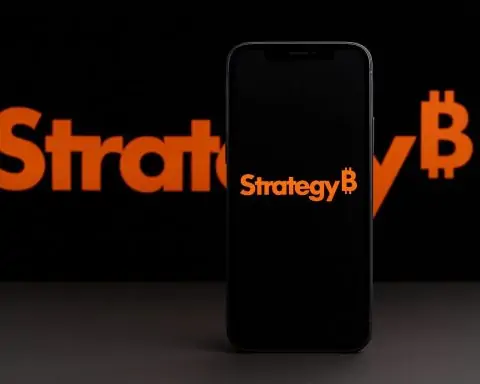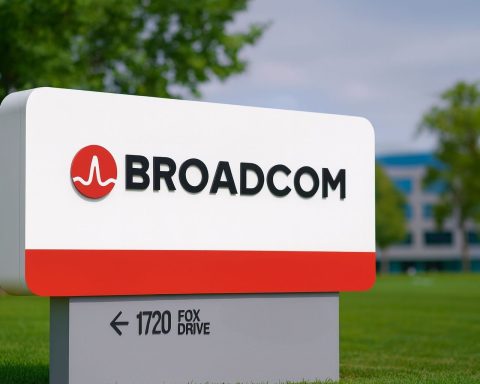Bank of America Corporation (NYSE: BAC) closed Black Friday trading higher, extending a strong fourth quarter as investors digest a powerful Q3 earnings beat, a fresh Federal Reserve rate cut, and an ambitious new growth plan from CEO Brian Moynihan.
Snapshot: BAC Stock on November 28, 2025
- Latest price: about $53.65 per share, up roughly 1.3% on the day
- Intraday range: roughly $52.00 – $53.94
- Trading volume: around 18.7 million shares, close to BAC’s typical full‑day average despite a shortened session [1]
- 52‑week range: approximately $33.06 – $54.69, putting today’s price only about 2% below its 12‑month high and more than 60% above the low [2]
U.S. markets ran on holiday hours today, closing at 1 p.m. Eastern time. Major indexes ended the Black Friday session modestly higher, with the S&P 500, Nasdaq and Dow up around 0.5%–0.7%, capping their best week since June in thin, post‑Thanksgiving trading. [3]
From the start of 2025 through today, BAC has gained roughly 20%, based on MarketBeat data showing the stock rising from about $43.95 at the beginning of the year to just above $53. [4] That move puts Bank of America ahead of some broad financial benchmarks and near the top of its recent trading range.
1. Why BAC Is Up: A Strong Q3 Still Driving the Story
Bank of America’s current rally is rooted in very strong Q3 2025 results, which surprised Wall Street on both earnings and revenue:
- Net income: about $8.5 billion, up 23% year‑over‑year
- Earnings per share:$1.06, beating consensus estimates around $0.95
- Total revenue: roughly $28.1–$28.2 billion, up around 11% from a year earlier and ahead of forecasts
- Record net interest income (NII): about $15.2–$15.4 billion, up roughly 9% year‑over‑year
- Investment banking fees: surged about 43% to $2 billion, helped by a rebound in M&A and capital markets activity [5]
Trading was solid as well, with equity and fixed‑income desks posting growth as clients repositioned portfolios in a more volatile macro environment. [6]
Crucially, credit quality improved rather than deteriorated:
- Provisions for credit losses fell to around $1.3 billion, down from roughly $1.5 billion a year earlier. [7]
- Bank of America’s own data show combined credit and debit card spending up about 6% year‑over‑year, while card delinquencies and charge‑offs ticked lower, signalling resilient consumer balance sheets. [8]
Segment‑level results underscored how broad‑based the strength was, with Consumer Banking, Global Wealth & Investment Management and Global Banking all contributing to the earnings beat. [9]
Taken together, Q3 was widely described by analysts as one of Bank of America’s best quarters in years, and that narrative continues to support the stock into the holiday season. [10]
2. Investor Day: Bigger Profit Targets, AI, and Expansion
On November 5, Bank of America held its first investor day since 2011 in Boston, a key event for shaping the stock’s medium‑term story. [11]
Key messages from management:
- Higher profitability target:
- New return on tangible common equity (ROTCE) target: 16%–18% in the medium term, up from a “mid‑teens” goal previously.
- BofA delivered about 15.4% ROTCE in Q3, versus roughly 20% at JPMorgan, and explicitly framed the plan as an effort to narrow that gap. [12]
- Net interest income growth:
- Management now expects NII to grow 5%–7% annually over the next five years, even as the Fed shifts toward a lower‑rate environment. [13]
- Investment banking & trading ambitions:
- Goal to add 50–100 basis points of market share in investment banking fees over 3–5 years.
- Targeting about 9% of the global trading revenue pool, up from roughly 7.6% today. [14]
- Wealth & consumer growth:
- The wealth business is aiming for 4%–5% net new asset growth per year, equating to roughly $135–$150 billion in additional fee‑earning assets annually. [15]
- Across the franchise, BofA wants to add millions of new U.S. customers over the next three to five years, with particular emphasis on cards, mass‑affluent clients and small businesses. [16]
- Expansion footprint:
- The bank plans to expand into six additional U.S. cities by 2028, including markets in Alabama, Louisiana and Ohio, which collectively represent more than $200 billion in potential deposits. [17]
- AI and tech:
- Executives highlighted artificial intelligence and digital channels as major levers for efficiency, saying AI will change the amount of work required per task, even if headcount doesn’t fall dramatically. [18]
The investor‑day message was clear: Bank of America knows it has trailed some rivals on returns, and it is publicly committing to close the gap via technology, disciplined expansion and higher‑margin businesses.
3. Fed Rate Cuts: A Mixed but Manageable Backdrop
The macro backdrop has shifted in BofA’s favor over the past two months.
On October 29, 2025, the Federal Reserve cut its benchmark federal funds rate by 25 basis points, setting a new target range of 3.75%–4.00% and signalling it would continue to monitor risks to both employment and inflation. [19]
Markets now widely expect another cut in December, and this week’s trading was buoyed by those expectations. [20]
For Bank of America, that setup is nuanced:
- Lower rates tend to pressure net interest margins over time as loan yields reset lower.
- But cuts can also stimulate credit demand, reduce funding costs, support asset quality and lift fee businesses such as investment banking and wealth management.
BofA’s management clearly leans toward the optimistic interpretation: their guidance calls for mid‑single‑digit annual NII growth for the next five years, even with these rate cuts, supported by loan growth and repricing of fixed‑rate assets. [21]
4. Dividends, Buybacks and Capital
Income‑oriented investors are paying close attention to BAC’s capital return profile, especially with the stock near its 52‑week high.
Dividends
- After this summer’s Fed stress test, Bank of America announced an 8% increase in its quarterly common dividend to $0.28 per share, starting in Q3 2025. [22]
- On October 23, the board reaffirmed a $0.28 dividend for Q4 2025, payable on December 26 to shareholders of record on December 5. [23]
At today’s share price around $53.65, that $1.12 annual dividend translates to a yield of roughly 2.1%, in line with MarketBeat’s calculation and competitive with other large U.S. banks. [24]
Bank of America also continues to pay regular dividends on its various series of preferred stock, reinforcing its image as a steady income name for institutional investors. [25]
Share repurchases
Alongside the dividend hike, BofA’s board authorized a $40 billion common‑stock repurchase program, giving management ample flexibility to retire shares when they believe the stock is undervalued or when organic growth doesn’t consume all of the bank’s excess capital. [26]
Regulatory capital remains a key swing factor to watch. International regulators recently updated their Global Systemically Important Bank (G‑SIB) list and buckets, modestly shifting required capital buffers for several large banks, including Bank of America. While the details are still being parsed, early commentary suggests BofA’s buffer changes are manageable and do not alter its capital‑return plans for now. [27]
5. Franchise Health: Consumers, ESG and Disaster Relief
Beyond the headline numbers, several recent developments speak to franchise strength and brand positioning:
- Consumer resilience: BofA’s spending data show U.S. consumers still active, with card transactions up around 5%–6% year‑to‑date and stable credit metrics, even as broader economic indicators show some softening in the labor market. [28]
- Support for wildfire‑affected homeowners: On November 21, the bank unveiled a “Rebuild Solution” targeted at mortgage clients affected by the devastating Altadena and Pacific Palisades wildfires in Los Angeles:
- Up to two additional years of mortgage forbearance beyond the typical 12‑month period
- A dedicated Rebuild Line of Credit, expected in early 2026, to cover costs not fully reimbursed by insurance
- Preservation of borrowers’ existing lower mortgage rates even as they rebuild [29]
6. Valuation: Is BAC Expensive Near Its Highs?
With the share price sitting just under its 52‑week high, valuation is front‑of‑mind for many investors.
Earnings multiples and “fair value” estimates
- MarketBeat data show BAC trading at about 14x trailing earnings, with a beta around 1.3, reflecting moderate sensitivity to broader market moves. [30]
- A recent fundamental analysis from Simply Wall St pegs Bank of America’s fair value around $59 per share, based on cash‑flow and earnings models—roughly 9% above today’s price. The same report puts BAC’s P/E ratio around the mid‑teens, slightly above the average for large U.S. banks but generally in line with global megabank peers. [31]
Analyst targets and ratings
- According to MarketBeat’s compilation, 23 analysts currently rate BAC as a “Buy” and five as a “Hold,” giving the stock an overall “Moderate Buy” consensus.
- The average 12‑month price target is about $57.8, implying high‑single‑digit upside from today’s level, plus the 2.1% dividend yield. [32]
Technical screens on TradingView, meanwhile, show an aggregated “neutral” stance from popular momentum and trend indicators, suggesting the stock is neither obviously overbought nor deeply oversold at current levels. [33]
Put simply: BAC no longer looks “cheap” in an absolute sense, but many analysts still view it as reasonably valued relative to its earnings power and growth targets—especially if management delivers on its new ROTCE and NII ambitions.
7. Who’s Buying (and Selling) BAC?
Institutional investors remain deeply involved in Bank of America:
- MarketBeat’s latest ownership data show roughly 71% of BAC shares held by institutions and hedge funds.
- Geode Capital, Norges Bank, Deutsche Bank, Amundi and Dimensional Fund Advisors all rank among the bank’s largest shareholders. [34]
Not every big holder is adding, however. Ceredex Value Advisors, for example, trimmed its BAC position by about 15% in Q2, selling just over 200,000 shares. Even after the sale, the stock still represented the fund’s 15th‑largest holding, underscoring its ongoing, if somewhat reduced, conviction. [35]
That mix of buying and selective profit‑taking is what you’d expect for a blue‑chip bank stock hovering near multi‑year highs.
8. Key Risks BAC Investors Are Watching
Despite the upbeat tone around earnings and strategy, several risk factors remain important for anyone following BAC:
- Interest‑rate path uncertainty
If the Fed cuts faster or deeper than expected, net interest margins could compress more sharply, weighing on NII and earnings power. [36] - Credit cycle and macro slowdown
While current credit metrics are benign, a sharper deterioration in employment or consumer confidence could drive higher charge‑offs in cards, autos and small‑business lending. [37] - Regulation and capital requirements
Changes to G‑SIB buffers, consumer‑protection rules, or capital treatment for trading and lending can raise capital needs or constrain growth, especially for globally systemic banks like BofA. [38] - Competition from peers and fintechs
JPMorgan, Goldman Sachs, Citi and a growing roster of fintechs continue to battle for investment‑banking share, wealth assets and consumer deposits, forcing BofA to keep investing heavily in technology and client experience. [39] - Market volatility and geopolitical shocks
As a large trading and investment‑banking franchise, Bank of America is exposed to swings in capital markets, deal flow and global risk sentiment, all of which can shift quickly.
9. What Today’s Move Could Mean Going Into December
So what does today’s Black Friday bounce actually tell us about BAC stock?
- Momentum is positive: Shares are near a 12‑month high and up roughly 20% year‑to‑date, reflecting renewed confidence after several years of lagging some peers. [40]
- Fundamentals are improving: Q3 showed double‑digit profit growth, record NII, robust investment‑banking fees and improving credit quality—a powerful combo for a megabank. [41]
- Management has raised the bar: The new 16%–18% ROTCE target and 5%–7% annual NII growth goal set a higher hurdle—and investors will be watching closely to see if BofA can execute. [42]
- Valuation is full but not frothy: At mid‑teens earnings multiples and a modest discount to some fair‑value estimates and analyst targets, BAC looks more like a quality compounder than a deep‑value turnaround at this stage. [43]
For long‑term investors, the key questions heading into 2026 are likely to be:
- Can Bank of America sustain mid‑teens or better ROTCE while the Fed cuts rates?
- Will the bank capture the investment‑banking and wealth‑management market share it’s now openly targeting?
- Does the combination of 2%+ dividend yield, buybacks and mid‑single‑digit earnings growth justify today’s valuation versus rivals like JPMorgan or Morgan Stanley?
How you answer those questions will largely determine whether you see today’s price near $53–$54 as a reasonable entry point, a hold, or an opportunity to take profits.
References
1. www.investing.com, 2. www.marketbeat.com, 3. www.investopedia.com, 4. www.marketbeat.com, 5. coincentral.com, 6. coincentral.com, 7. www.reuters.com, 8. www.emarketer.com, 9. www.alpha-sense.com, 10. seekingalpha.com, 11. www.reuters.com, 12. www.reuters.com, 13. www.reuters.com, 14. www.reuters.com, 15. www.reuters.com, 16. www.bankingdive.com, 17. www.reuters.com, 18. www.reuters.com, 19. www.federalreserve.gov, 20. www.reuters.com, 21. www.reuters.com, 22. newsroom.bankofamerica.com, 23. newsroom.bankofamerica.com, 24. www.marketbeat.com, 25. newsroom.bankofamerica.com, 26. newsroom.bankofamerica.com, 27. www.zacks.com, 28. www.reuters.com, 29. newsroom.bankofamerica.com, 30. www.marketbeat.com, 31. simplywall.st, 32. www.marketbeat.com, 33. www.tradingview.com, 34. www.marketbeat.com, 35. www.marketbeat.com, 36. www.federalreserve.gov, 37. www.reuters.com, 38. www.zacks.com, 39. www.reuters.com, 40. www.marketbeat.com, 41. coincentral.com, 42. www.reuters.com, 43. simplywall.st








